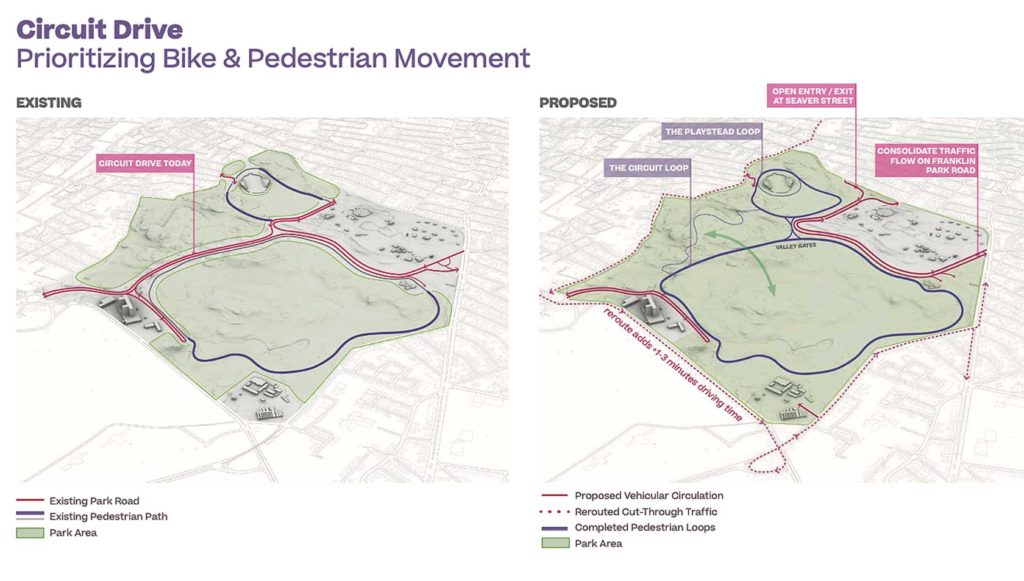Plan would divert Franklin Park traffic through Roxbury
Cars would exit at Humboldt in proposal under consideration

In 2018, with the sale of the Winthrop Square Garage, then-Mayor Martin Walsh committed $28 million to revitalize Franklin Park — a promise that is now coming to fruition. However, with proposed plans including closing one of the park’s major through roads to automotive traffic, neighbors are expressing concerns over increased congestion and the sacrifice of invaluable community assets within the park’s outer regions.
The team designing the park’s revitalization plan, which includes members from the Cambridge-based landscape architecture firm Reed Hilderbrand, Mass Design Group and Agency Landscape + Planning, is recommending that Circuit Drive, which bisects the park, be closed to auto traffic. They’re proposing a pedestrian and bicycle promenade that would circle the park’s central golf course. Under this scenario, traffic would enter the park near the entrance to the zoo opposite Columbia Road and exit at Humboldt Avenue and Elm Hill Avenue.
According to residents and community advocates who live on the Humboldt Avenue side of the park, this would route traffic right past a playground and through an area currently used for BBQs, increase congestion along Seaver Street and disrupt bus routes that go through the park. Residents on the Seaver Street side of the park are predominantly African American and Latino. Residents on the Forest Hills side of the park, near where Circuit Drive currently exits the park, area predominantly white.
“It’ll make [traffic] incredibly more difficult, it’ll add more time and create more safety issues of people who are trying to circumnavigate the park,” said Louis Elisa, a founding member of the Franklin Park Coalition. “If you close down Circuit Drive, everybody who’s coming through from Milton, and Brockton and Randolph, they’re now going to try to come to Blue Hill Ave.”
According to documents from the park planning team, the closure of Circuit Drive is estimated to add one to three minutes to driving time around the park. Planning documents also express a need for new traffic patterns to reduce Blue Hill Ave congestion by utilizing Peabody circle and creating strategies with the Boston Transportation Department (BTD).
Ultimately, the team looks to be prioritizing reducing reported noise and safety issues caused by low-riding vehicles, high-speed cut-through traffic and drag racing that take place in the area.
“We want to elevate multimodal routes for bikes and pedestrians, connect visitors to major park destinations, including parking, and vehicular circulation,” Lydia Gikas Cook, a senior associate at Reed Hilderbrand said during a May 19 community meeting.
Elisa thinks the planners are out of their depth. He linked the plan to close Circuit Drive permanently to the temporary closures effected by the Boston Police Department in response to noise complaints.
Elisa said that using the noise complaints to justify “closing down access and forcing people to drive almost a mile out of their way to get from one product is just simply racist.”
In a conversation with the Banner, he also went on to say that the noise is not a chronic issue — unlike the congestion that would be caused as a result of the rerouted traffic.
In addition to the congestion issues, neighbors have also shared concerns that the planning process has been out of touch, and not centered equity.
“If I was to categorize the people who were making these decisions? They’re the people who don’t live in Mattapan, Dorchester or Roxbury, because they’re not the ones whose door it’s at,” said Fatima Ali-Salaam, chair of the Greater Mattapan Neighborhood Council.
She said that with positioning heavy traffic near a playground and in front of the homes of minority residents, health and safety become issues — issues that haven’t been at the center of planning decisions.
“Why would you reroute traffic directly around neighborhoods which already have some the highest rates of asthma in the city? Why would you do that? That makes no sense,” Ali-Salaam said.
Virtual meetings, open to the public, have been held over Zoom with breakout rooms for open discussion on the multi-faceted plan. The last meeting, held in May, had vocal opinions on both sides of the issue, according to John Kett, a managing principal at Reed Hilderbrand.
“I would say we had a full spectrum of people who were very strongly opposed and supportive of the proposal, along Circuit Drive in particular, as it came to safety and experience within the park.”
He added that the input gave a “reality check, questions about increased frequency of access on the 16 bus line and some other things that will have impacts to the feasibility of the proposal, and how because of that, things may get incrementally implemented over time.”
Parks Department Commissioner Ryan Woods said the city is committed to increasing bicycle and pedestrian access in the park, but he stopped short of full support for closing Circuit Drive.
“The City and the community share a common goal: making Circuit Drive a more integral, safe, multi-modal way that promotes park use,” he said in a statement emailed to the Banner. “We look forward to continuing to work with the community to explore ideas and see what strategies fit best.”
The opportunity for public input is soon coming to a close, with the action plan set to be final at the end of the summer or in early fall. Both Elisa and Ali-Salaam said neighborhood advocates will continue to send letters and express public concern to the planning team.
“They will continue to do this. And the community says, we don’t want it. It’s not safe. It puts us at risk,” Elisa said.






